A new conventional wisdom began to spring up around free software, led in part by theorists like Eric Raymond, who were interested in the economics of free software production. Much of this thought centered around service-based and other ancillary sales for supporting free software. Based on this kind of thinking, it's fairly easy to imagine extending free licensing ideas to utilitarian works. But what about aesthetic works? The Creative Commons was established in 2002, largely to solve the kinds of licensing problems that aesthetic works might encounter, and it has been remarkably successful, pushing the envelope of even this newer wave of thought. Today, Creative Commons licensed works number in at least the tens of millions. And more than a quarter of those are using the free "Attribution" or "Attribution-ShareAlike" licenses.
The problems with free-licensing aesthetic works
The economics of free software is not so difficult to support. After all, we don't value software for what it is, but for what it does. No one really just sits and admires Microsoft Word, or LyX, or AbiWord. They use one of these programs to create written works. An interoffice memo written in AbiWord may be indistinguishable from one written in MS Word, and AbiWord is cheaper and more flexible. Thus, from the user's point of view, AbiWord may be a complete replacement of Microsoft Word.
If, on the other hand, you were putting together a museum collection of "word processing programs", AbiWord would not be interchangeable with Microsoft Word: only Microsoft Word can stand in such an aesthetic role for Microsoft Word. Works, when valued aesthetically, are never interchangeable.

That was a contrived example, because software usually isn't valued aesthetically. But this is the norm for artistic works. If you are a Beatles fan, you will never be satisfied with a free-licensed band that just "sounds a lot like the Beatles" or "can be used the same way as the Beatles songs".
Works, when valued aesthetically, are never interchangeable
It is also fundamentally impossible to prove the relative objective worth of aesthetic works. For utilitarian works, we can always list a set of objective criteria, test different products, and evaluate which is "best" according to those criteria.However, for aesthetic works, such judgements must always be subjective. At best, we ask a larger or more representative group of people to give their opinion (in other words, we can report objective facts about collected subjective opinions), but that's the best we can do.
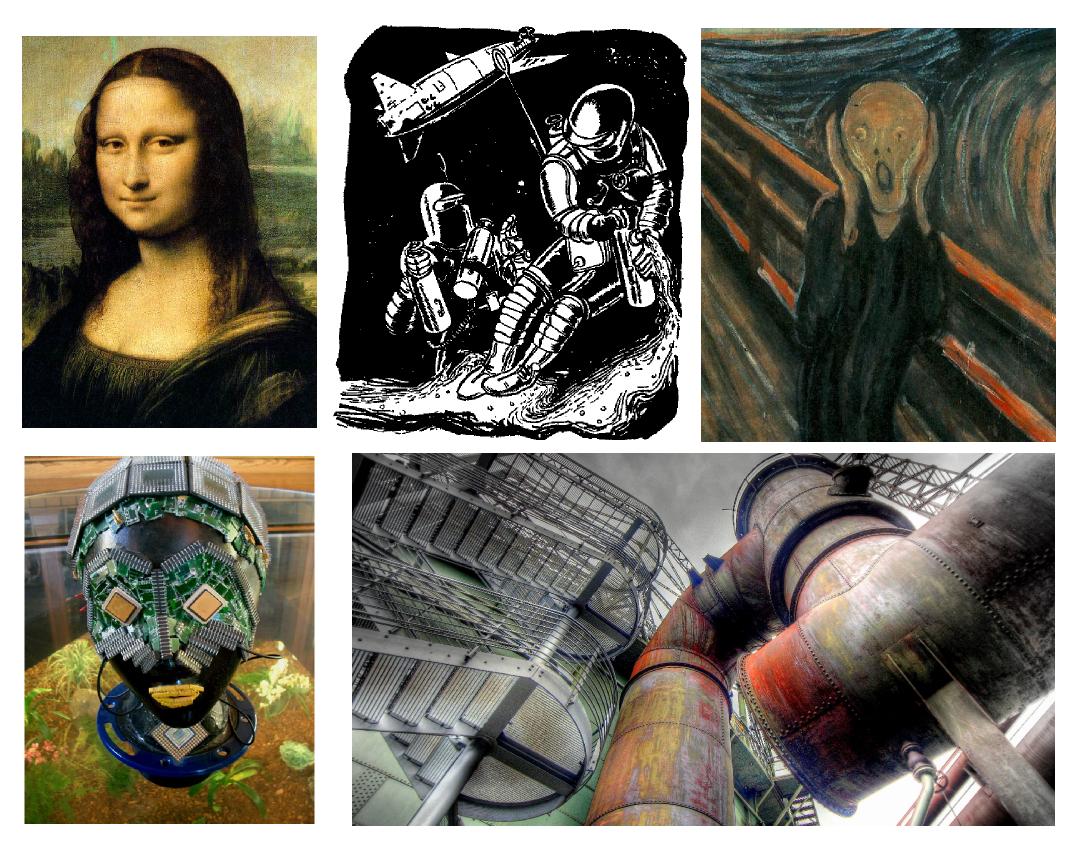
Beauty is in the eye of the beholder
At the same time, aesthetic works lack many of the ancillary funding opportunities of utilitarian works like free software. It's pretty hard to sell a service contract on a painting or a music track. So, while there is still great public benefit in creating free-licensed aesthetic works, the economic support structure which enables the private parties who would create this benefit to be remunerated by the public for their efforts is missing.
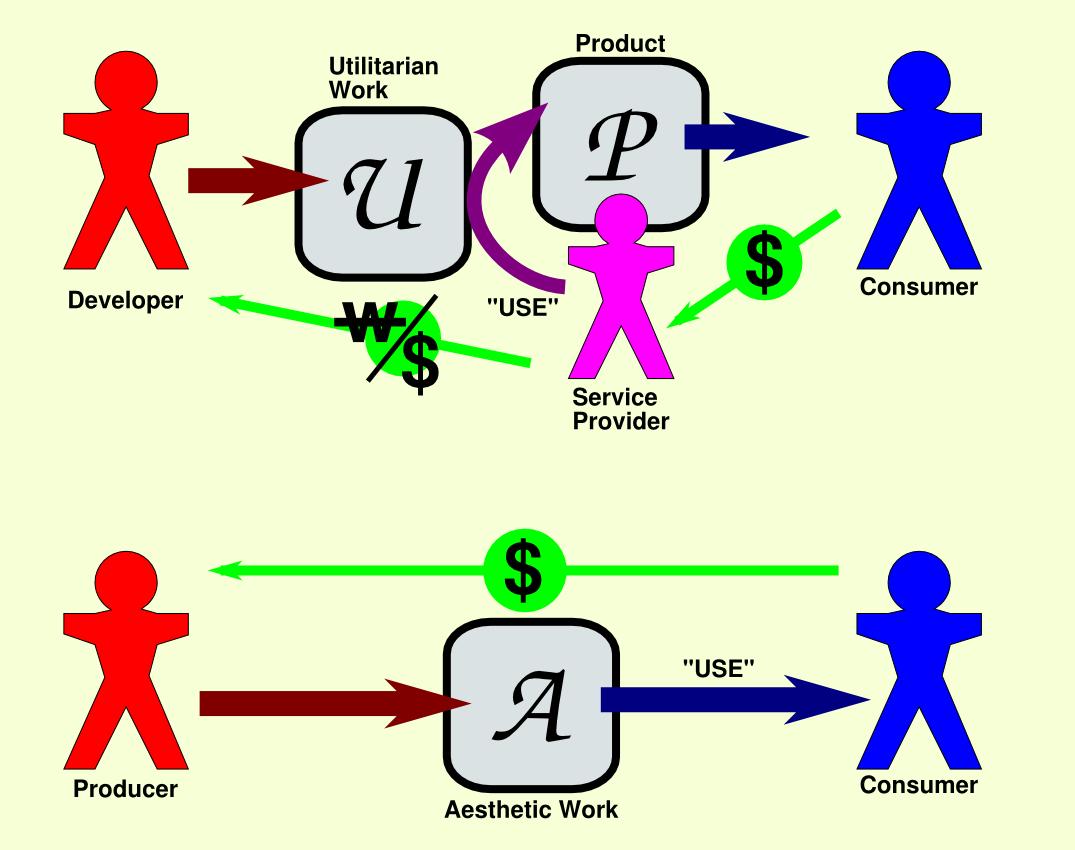
It's pretty hard to sell a service contract on a painting or a music track
Aesthetic works have one other important property, which is that they are used to communicate opinions and make political statements. With aesthetic works, we directly influence people's opinions and sometimes their actions. Such statements also reflect on the author's reputation (for both intent and talent), which can lead to strong positive or negative consequences.

Some artists may not appreciate seeing their work "improved" by others
Thus, aesthetic works present special challenges for free licensing and economics. And this leads to today's "Myth".
Myth #3
"Well okay, free works can succeed if they are purely utilitarian, but what about culture and art?"
This is one of the most sophisticated objections to free culture, and the hardest to refute. But we will see that there are ways that free culture continues to produce aesthetic works.
The Creative Commons
In 2002, Larry Lessig founded the Creative Commons to solve artistic licensing problems with a modular system of licenses designed to accommodate the needs of creators of "creative"—or more accurately, "aesthetic"—works. Since then, the mission of the Creative Commons has been to simplify the existing network of use cases by defining a finite set of license modules, and then combining those into generally useful licenses for all kinds of media.
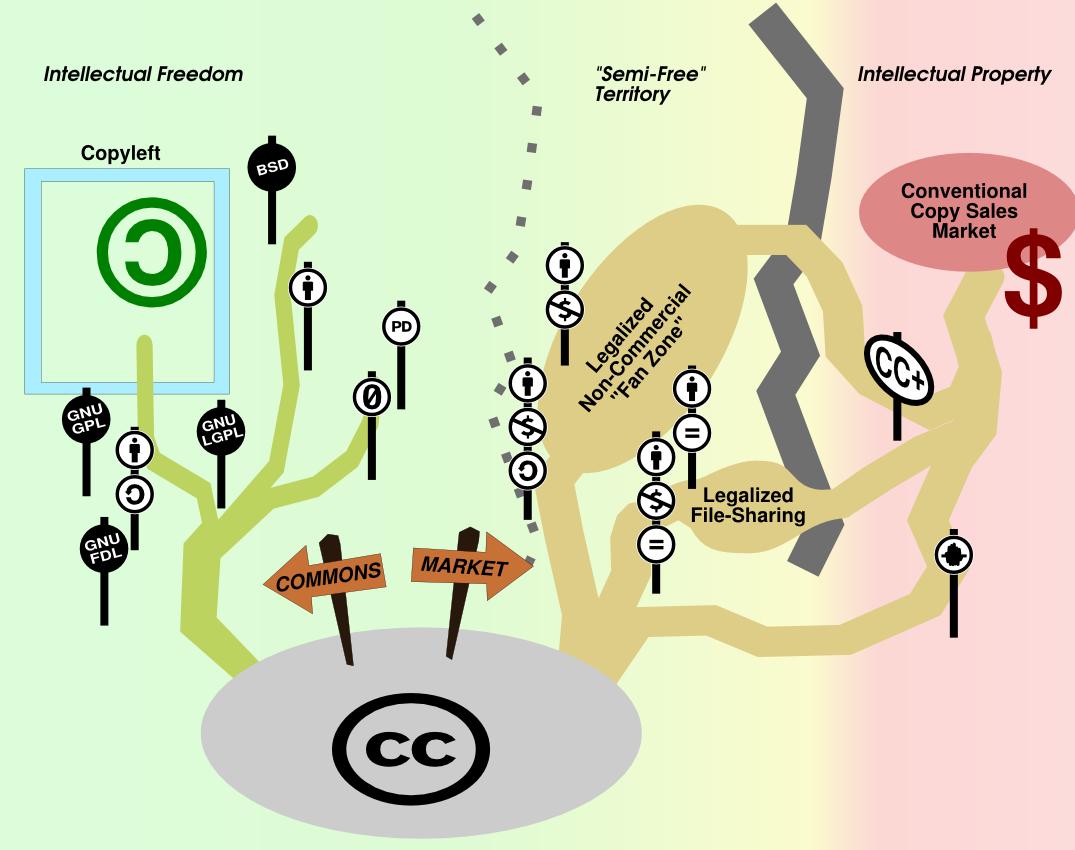
The organization provides three types of information products for each of its licenses: the actual license, which CC calls the "legal code" (meant to be understood by lawyers and meticulously detailed in meaning); a brief set of descriptions intended to help licensors and licensees to understand what they are choosing, which CC calls the "deed"; and a machine-readable RDF representation which helps search engines and other AI tools to recognize and sort CC licensed material.
Creative Commons licenses span a plethora of use-cases and user communities
In addition to creating new licenses principly targeted at aesthetic works, the Creative Commons has also subsumed the pre-existing GPL and LGPL licenses for software, by providing the "deed" and RDF code to complement the existing licenses' "legal code".
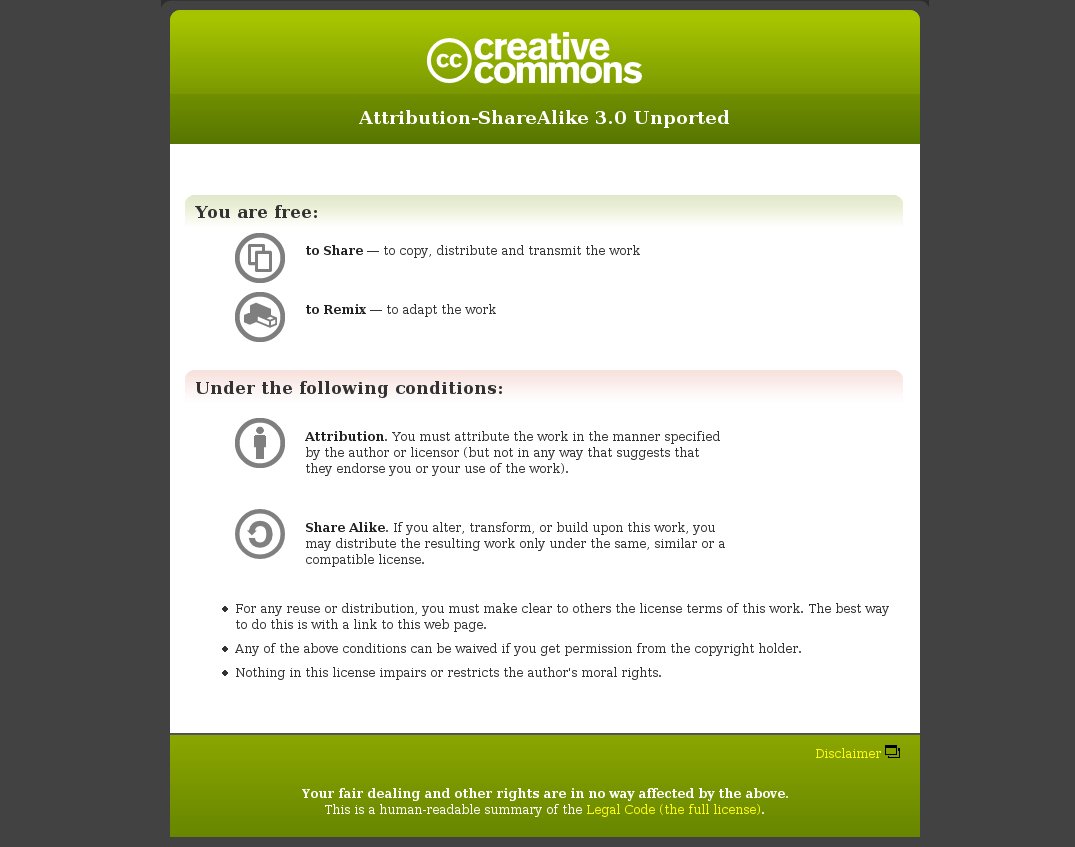
Measuring the success of Creative Commons licenses
It is extremely difficult to find any accurate figures on the total adoption of Creative Commons licenses. The existing studies worked by doing search queries through major commercial search engines (Yahoo and Google), using features which allow tracing "backlinks" to the Creative Commons license pages. The Creative Commons has made some attempts to measure adoption statistics, however, which are intriguing.[1]
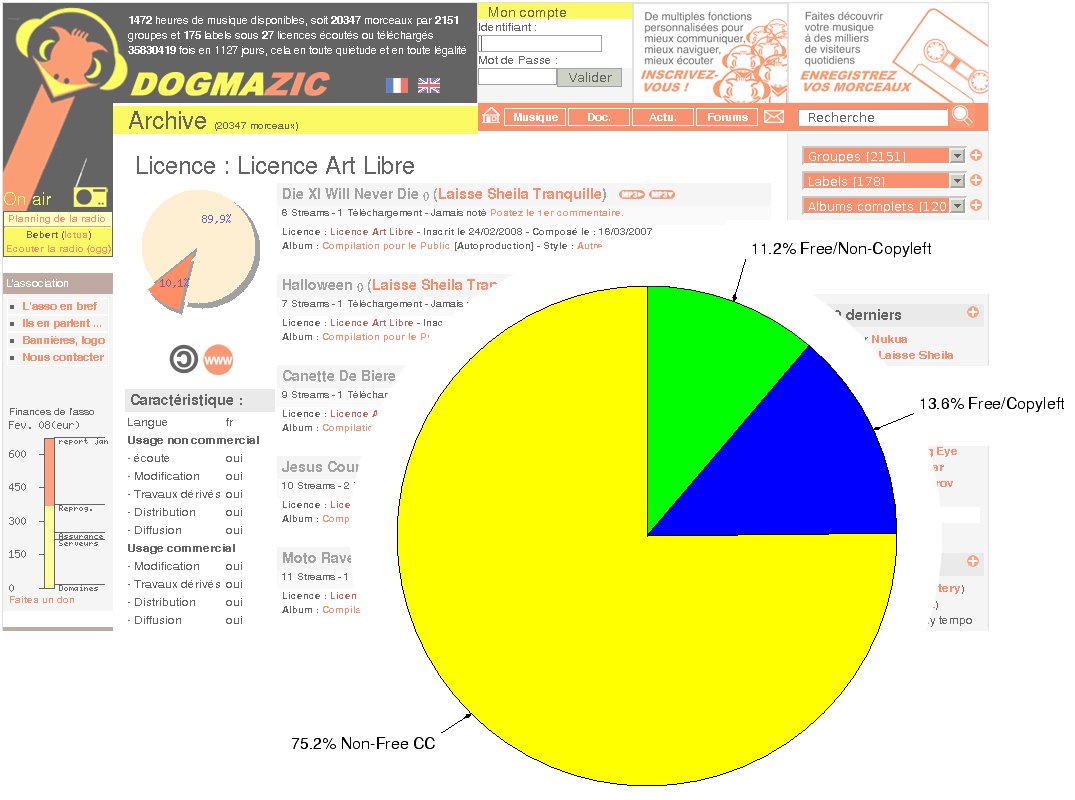
There are several things that are suspect about this approach, including the incompleteness of search engine databases, the uncertainty in determining that backlinks necessarily equate to license assertions, and the assumption that there is a one-to-one relationship between license assertions and licensed works. However, in the absence of better data, it's worth looking at the statistics that Creative Commons has been able to publish.
It is extremely difficult to find any accurate figures on the total adoption of Creative Commons licenses
Creative Commons' own analysis of the data is somewhat misleading, because it treats the separate license modules as if they were orthogonal (i.e. as if use of the "ShareAlike" module means the same thing, regardless of whether the "Non-Commercial" module is used or not). So, I have re-classified the data for my own analysis, dividing the licenses into "Free/Non-Copyleft" ("Public Domain" and "Attribution"), "Free/Copyleft" ("Attribution-ShareAlike"), and "Non-Free CC" (all licenses with "Non-Commercial" or "Non-Derivative" modules).
In general, the "Non-Free CC" licenses have been very successful, probably reflecting a general dissatisfaction with decreasing fair use, increasingly closed "intellectual property" legislation, and attacks on file sharing over the internet. However, these licenses are not "free" in the same sense as "free software", and represent a distinct phenomenon from the growth of the "Free" licenses.
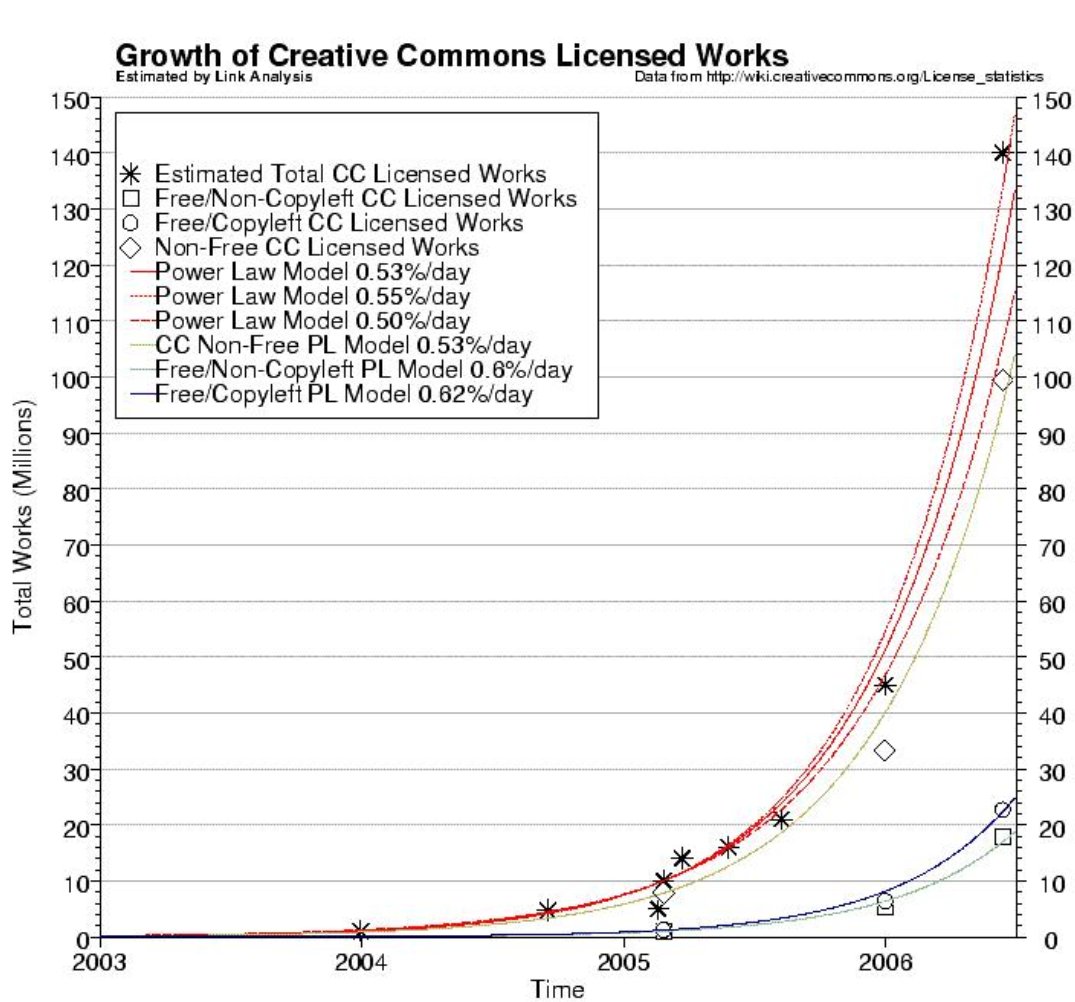
From early on in the Creative Commons' history there has been a political debate over whether the "Non-Free" licenses are helping or harming the adoption of "Free" licenses. The data don't necessarily support either position, but it's clear that the free licenses are succeeding, whether because of or in spite of the other Creative Commons licenses.
It's clear that the free licenses are succeeding, whether because of or in spite of the other Creative Commons licenses
The most recent study on the Creative Commons licenses was conducted by an outside research group at Singapore Management University in 2007, and was hopefully more controlled in its handling of the source data. It estimated a lower bound of about 60 million CC license backlinks, based on data from Yahoo and Flickr. In this study, the "Free/Non-Copyleft" group represents 12%; the "Free/Copyleft" is 18%; and the "Non-Free" group is 70%.[2]
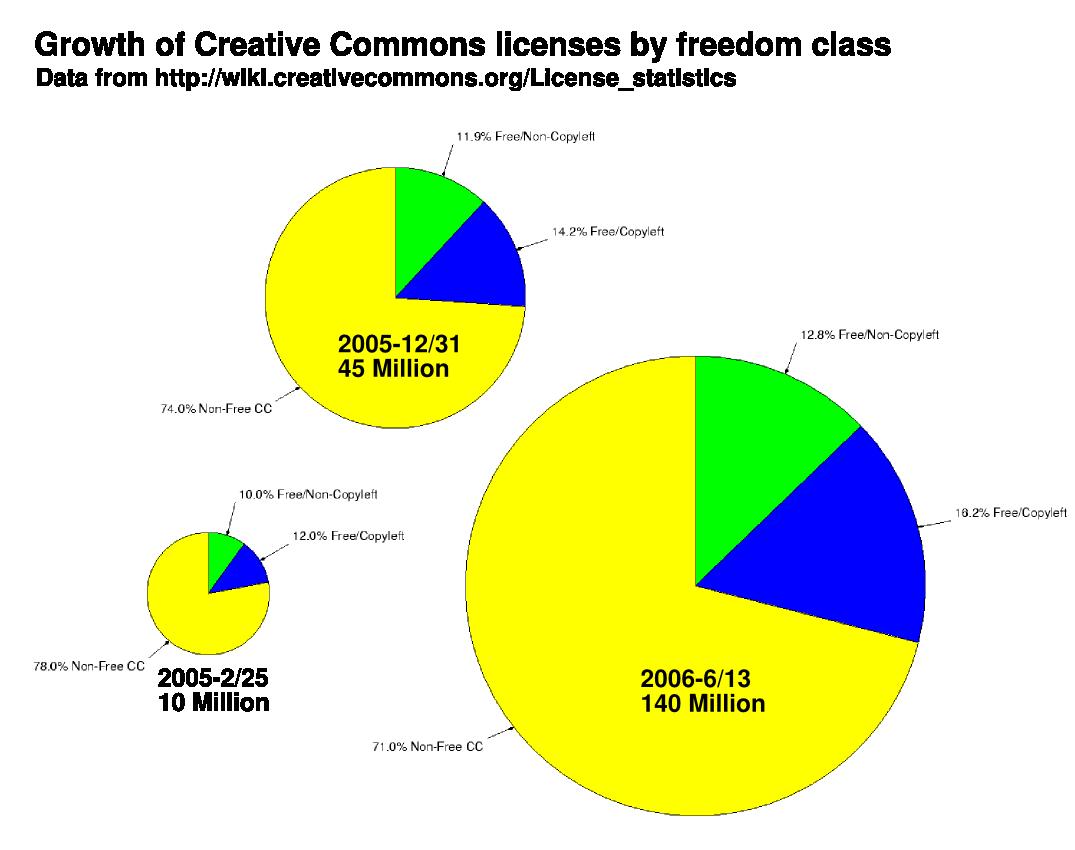
Freedom for the mainstream
Despite the shakiness of the theoretical foundation for producing aesthetic works professional and releasing them under free licenses, a lot of material is nevertheless being produced. Is this material created just by amateurs? (If so, they are producing a lot of it!)? Or is it the result of business models we have not considered? The non-free licenses from Creative Commons signal a broader, more mainstream cultural phenomenon of people who are disenchanted with the "more is better" attitude towards copyright that the proprietary industry has shown.
There are still many questions, but the Creative Commons and the free culture surrounding it is going strong.
——
Notes
[1] Creative Commons License Statistics, from the CC wiki.
[2] Giorgos Cheliotis Singapore Management University Study
More Impossible Things
This column is part of a series called "Six Impossible Things Before Breakfast":